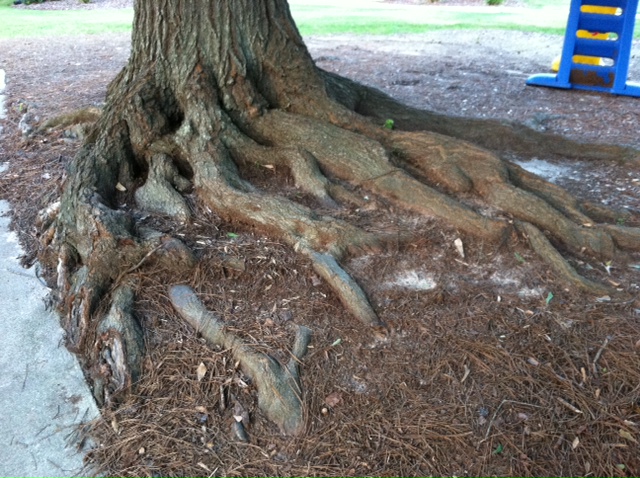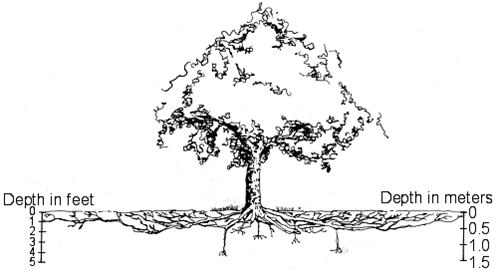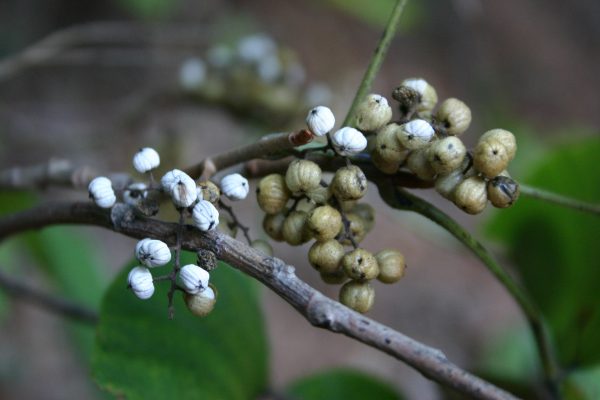Tree – Covering Exposed Roots

D.S. recently sent me a question I have heard over and over again after heavy, eroding rains. “I have a maple tree whose roots are showing through the soil around it.” he wrote. “How much new topsoil should I put over the roots in order to protect them so I can plant fescue?”
Surface roots are common around maple trees, particularly silver maples. Maple roots have a great need for oxygen. When a tree is first planted, the roots grow outwards just below the soil surface, where oxygen is plentiful. If there is even the least bit of erosion or human traffic under the tree as it ages, the roots are exposed. As the tree grows larger the roots expand as well. Sometimes they can be one to four inches above the surrounding soil. A lawn mower blade that hits a solid, concealed root hidden by grass will twist like a pretzel!
All tree roots have some need for oxygen. Some species need more, while others can live with their roots covered entirely by water. Oxygen is just as vital for tree respiration as it is for our own. Oxygen is absorbed by the tree’s feeder roots, which continually grow, die and regenerate along and at the ends of the woody, permanent roots which extend from the base of the tree.
If too much soil is added above the feeder roots of a tree they can suffocate. Imagine how well you’d breathe with a pillow over your face! Coarse soil, however, doesn’t block oxygen nearly as much as a layer of heavy clay soil.
MY RECOMMENDATION? Cover the permanent, woody roots nearest the tree trunk with two inches of good quality planting soil – not the cheap $.99 per bag topsoil. I’m sure that area is where he most notices the exposed roots. The all-important feeder roots are located predominantly under and well beyond the drip-line of the tree. No soil should be added above the feeder root area.
CHIP MULCH I cautioned D. that fescue might not grow near the maple tree trunk due to the shade there. In that case a layer of mulch would be an attractive alternative to grass.
I’m commonly asked if wood chips from a tree removal company can be used safely as a mulch. According to tree scientists, as long as the layer of mulch is no more than two inches high, chips can be used without harm. Fresh chips do contain certain chemicals that inhibit root growth so a thick layer under trees or shrubs is not a good idea. Two inches of fresh chips shouldn’t be a problem however.
PLANT WARS Speaking of mulch, I don’t think we realize how much better it is to mulch under a tree rather than try to grow grass. Planting a tree in the middle of a lawn sets up a battle royal between the two species. Grass roots have the advantage when it comes to grabbing water and nutrients. Fine and fast-growing, they colonize the upper six inches of soil and scavenge most of the moisture and fertilizer that is applied. Tree roots desperately search among the grass roots, trying to find what resources they can.
Tree leaves, however, have the advantage when it comes to gathering sunlight. As the tree branches grow more dense with leaves, less and less sunshine falls on the grass below. As the grass thins, the tree is able to accumulate more of the water and nutrients it needs.
For this reason, if you want a fast-growing, healthy tree consider mulching the entire area under the drip-line and a few feet beyond. By duplicating a more natural woodland environment for the tree you’ll have few exposed roots, a healthier tree and less conflict between it and your grass.















